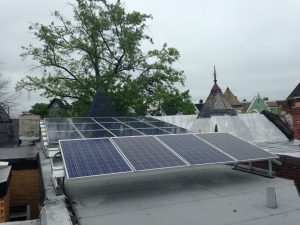March is B Corp Month and TCG is highlighting some of the ways that we work to improve the world around us.
In December of 2021, the White House released an Executive Order (EO) to promote sustainability in the Federal government. The “Executive Order on Catalyzing Clean Energy Industries and Jobs Through Federal Sustainability” set government-wide sustainability goals for electricity, vehicles, buildings, and other operational areas. Several sections of the EO include requirements for acquisitions and procurements, meaning that contractors like TCG must be prepared to meet these sustainability goals.
As a Certified Benefit Corporation and a Public Benefit Company, understanding and reducing our environmental impact is a priority for TCG, and we’re excited to see the Federal government move toward greater sustainability. As a vendor to several Federal agencies, we wanted to assess how our own sustainability goals line up with those detailed in the EO. Fortunately, thanks to the requirements of Certified Benefit Corporations, we find ourselves ahead of the game. Every year we assess our impact in five key domains, including the environment, and set goals for the following year. We can easily see how our corporate goals and initiatives align with the principles set forth in the EO and fit into the larger context of the government contracting industry.
GreenHouse Gas Emissions
The EO aims to reduce carbon pollution and greenhouse gas emissions. These include:
- 100 percent carbon pollution-free electricity on a net annual basis by 2030
- 65 percent reduction in scope 1 and 2 greenhouse* gas emissions from Federal operations by 2030, from 2008 levels
- Net-zero emissions from Federal procurement
TCG has set a greenhouse gas emissions reduction goal of a 10% emissions intensity (2% per year) per Full Time Equivalent (FTE) employee by 2025. TCG’s office in Washington D.C. generated 2.3 metric tons of carbon dioxide equivalent (mtCO2e) of greenhouse gas emissions for the 2019 calendar year and 1.5 mtCO2e of greenhouse gas emissions for the 2021 calendar year. This represents a 34.5 percent reduction from 2019 when we began tracking emissions.

TCG has also made efforts to obtain clean energy for TCG headquarters. In 2018, the company purchased solar panels for its new headquarters building. In 2019, the 8,382kWh of electricity used at headquarters produced 5.9 metric tons of carbon dioxide, but this was offset through the solar panels which produced 8,149 kWh, saving 5.8 metric tons. The solar panels did such a good job of offsetting our greenhouse gas emissions from energy that we only needed to purchase a small offset from Terrapass for our energy-use emissions.
Terrapass is a carbon offset provider, to help ensure that we are offsetting our greenhouse gas emissions. Carbon offsets are not a reduction strategy. Rather they seek to mitigate the impact we have as a company. They are a good way for the company to mitigate our environmental impact in the short term while finding long-term strategies for carbon reduction.
Two factors complicate TCG’s sustainability goals. First, TCG’s workforce is entirely dispersed, with the majority of employees working from home or, before the pandemic, at client sites. TCG’s headquarters was never a primary work site for the majority of the company, making it difficult to account for the company’s total carbon footprint because those employees at client sites should be accounted for in the energy usage at Federal facilities. Second, the pandemic changed this dynamic as the Federal workforce went almost entirely remote, reducing energy consumption on site and through commuting. This skews the data for the last two years on energy consumption at Federal offices. As contractors return to work on site, it will be important for TCG to continue to track data around associated greenhouse gas emissions.
Prior to the pandemic in 2019, employees that worked from home, used public transportation, biked, and walked to work saved a combined 809,640 miles and almost 37,000 gallons of fuel.
Tracking
The EO requires GSA to track disclosure of greenhouse gas emissions, reduction targets, climate risk, and other sustainability-related actions by major Federal suppliers. While this policy does not necessarily apply to TCG, the company does track and disclose emissions as part of Federal Acquisition Regulation requirements and embraces the idea of disclosing environmental impact and sustainability goals. This information is available in our Annual Benefit Report.
To date, we have identified and collected information on:
- Headquarters electricity/gas use – total kilowatt hours (kWh) used on the electric and gas bills;
- Water supply and treatment – total cubic meters (m3) used on the water bill;
- Staff commuting; and
- Energy usage and savings through working from home.
TCG is working with HXE Partners to track our greenhouse gas emissions and set emissions reduction goals.
Summing Up
A strong belief in looking beyond our bottom line to the well-being of our communities, country, and the world was the reason TCG became a Public Benefit Company and Certified B Corp. Taking steps towards greater sustainability in our industry – working with the Federal government – is a crucial part of this mission. We are encouraged that our Federal partners are moving in the same direction.
You can read our Annual Benefit Report for more information on what being a B Corp means to TCG and actions we’re taking to reduce our carbon footprint.
*Per the EPA definition, “Scope 1 emissions are direct greenhouse (GHG) emissions that occur from sources that are controlled or owned by an organization (e.g., emissions associated with fuel combustion in boilers, furnaces, vehicles). Scope 2 emissions are indirect GHG emissions associated with the purchase of electricity, steam, heat, or cooling. Although scope 2 emissions physically occur at the facility where they are generated, they are accounted for in an organization’s GHG inventory because they are a result of the organization’s energy use.”